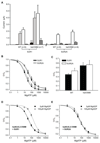Muscle dysfunction caused by a KATP channel mutation in neonatal diabetes is neuronal in origin
- PMID: 20595581
- PMCID: PMC5890903
- DOI: 10.1126/science.1186146
Muscle dysfunction caused by a KATP channel mutation in neonatal diabetes is neuronal in origin
Abstract
Gain-of-function mutations in Kir6.2 (KCNJ11), the pore-forming subunit of the adenosine triphosphate (ATP)-sensitive potassium (KATP) channel, cause neonatal diabetes. Many patients also suffer from hypotonia (weak and flaccid muscles) and balance problems. The diabetes arises from suppressed insulin secretion by overactive KATP channels in pancreatic beta-cells, but the source of the motor phenotype is unknown. By using mice carrying a human Kir6.2 mutation (Val59-->Met59) targeted to either muscle or nerve, we show that analogous motor impairments originate in the central nervous system rather than in muscle or peripheral nerves. We also identify locomotor hyperactivity as a feature of KATP channel overactivity. These findings suggest that drugs targeted against neuronal, rather than muscle, KATP channels are needed to treat the motor deficits and that such drugs require high blood-brain barrier permeability.
Figures




References
Publication types
MeSH terms
Substances
Grants and funding
LinkOut - more resources
Full Text Sources
Medical
Molecular Biology Databases

